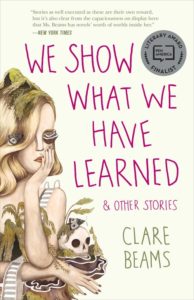
In the title story of Clare Beams’ lush, imaginative debut collection, We Show What We Have Learned, a fifth-grade teacher begins to fall apart in front of her students after a boy makes a crude joke about vaginas. Her “disintegration” isn’t merely symbolic, though; it’s real: “Here are the parts that Mrs. Swenson lost in the days that followed: three molars, the end of her nose, a chunk of one shoulder, which she shook from her sleeve, her lower lip, and assorted fingers and toes…” Beams’ stories, a cross between Aimee Bender’s and Karen Russell’s, are set in dreamy otherworldly places that are almost recognizable—but not quite. By making her metaphors literal, Beams creates magical-realist pieces that often calculate the high cost of being a woman.
In “Hourglass,” the narrator, Melody, enrolls in the all-girls Gilchrist School because it offers a “transformational education.” Though Melody’s home life is only hinted at, it’s clear that her mother isn’t happy with who Melody is—the kind of girl who likes nothing better than to hole up in her room with a Nancy Drew mystery—and wants to see her “blossom.” As the story unfolds, we learn that the headmaster, Mr. Pax, possesses rather old-fashioned notions about education. First appearances are everything to him, and looks matter. Melody dons a dress, a hat, and finally a corset because girls ought to be pleasing to the eye. And this is just the beginning of the transformations Mr. Pax envisions for his young female pupils. In “The Drop,” Lily Baker’s fiancé, Martin, brings home the parachute that saved him in the war and asks Lily to fashion it into her wedding dress. Lily is unhappy. The dress is not what she wanted, but that’s just a trifling matter in this cautionary tale about the sacrifices required of wives, especially the wives of soldiers traumatized by the war.
These stories have been called feminist; the downside of the some feminist literature is that it may focus too exclusively on how men and a patriarchal society victimize women and how women damage each other in competition for men. There’s a bit of that dynamic at play in We Show What We Have Learned. “Ailments,” set during the plague in England, explores how competition almost divides two sisters. The narrator, who clearly thinks she is intellectually superior to her sister, Frances, is practically undone by her desire for Frances’ husband. She’s also deeply suspicious of how her sister could possibly be stimulating enough for her doctor husband. Even after the narrator observes something important (I won’t give it away) that shows her sister in a more favorable light, the narrator’s ardor for the doctor barely cools, and the story ends before we see how this information might change her relationship with her sister. “The Renaissance Person Tournament” turns on a lie that one woman tells another in order to help her. The narrator, a middle-aged female teacher, sets up her protégé to win an academic tournament by bluntly informing the high school girl that the boy is she is competing against is not romantically interested in her. It’s true that the teacher has good reason to be suspicious of the boy’s intentions, but it’s also depressing that the only way to help her student is by wounding her.
But even when their plots feel slightly didactic, these stories are constructed from gorgeous, finely fashioned sentences. Beams’ flair and originality, and her ability to make sense of the objects of the world, are striking. When one of the teachers at Gilchrist sheds her dress and corset, she is “nothing but the filling-in of a corset, something poured inside to allow the corset to stand up, walk around, and go about its life.” A cottage in “Ailments” has the “blank-eyed look of a slow child” and the heat of the day makes the “leaves of the trees… limp; they looked as fat and wet as eating-greens.” The teacher’s detached earlobe in “We Show What We Have Learned” sits “on the ground like a fat, self-satisfied grub, one that had perhaps eaten its brethren. Mrs. Swenson’s small gold hoop earring was still in place, puckering the roundest part of the lobe’s belly.”
Beams’ triumph comes in “World’s End,” a story about loss and longing told through the eyes of an architect who is preparing a vast peninsula outside of Boston for development. Landscape writing can feel so static, but Beams’ descriptions make both buildings and geographical features come alive. Cale, the tycoon who hires the architect, lives in a big house on a hill. “They had flattened most of it,” the architect observes, “and piled the rest beneath the structure, in a stylized bulbous hill that worried at his eyes. The effect was like a cherub’s cheek carved into a living face.” The peninsula, itself, “rolled and pitched as if it lived, as if it had only momentarily consented to be still.” He designs a road so that it will “just lip the breast of the hill…” Beams’ descriptions dazzle here; indeed, the young architect is so transported by the vistas he has had a hand in creating at World’s End that he fails to see himself very clearly and nearly ruins his career. That’s the danger in We Show What We Have Learned where at every turn the characters have to try to unlearn what society or school has taught them.




